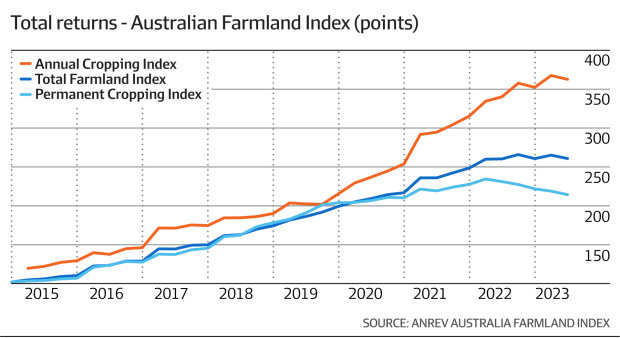Farmland returns fall below 1pc as rate rises, weak beef prices bite

Lower commodity prices, higher interest rates and forecasts of drier conditions have severely dented farmland returns, according to a benchmark index tracking the performance of a $2 billion portfolio of prime grade assets managed by the country’s leading agricultural asset managers.
Over the 12 months to September 30, prime productive farmland delivered just a 0.2 per cent total return, the weakest annualised result since the inception of the Australian Farmland Index in March 2015.
This compares with the index’s total average annualised return of 11.57 per cent, highlighting that farmland has entered into a cyclical downturn after booming since the end of the last drought.

The index, compiled by the Asian Association for Investors in Non-Listed Real Estate Vehicles (ANREV), includes farmland controlled by Rural Funds Management, manager of ASX-listed Rural Funds Group, private equity firm ROC Partners, and fund managers Gunn Agri Partners and Growth Farms Australia.
About 44 per cent of the index portfolio is made up of permanent farmland (mostly horticultural plantings such as grapes, nuts and citrus), with the remaining 56 per cent comprising annual farmland producing commodities including wheat, cotton, barley and livestock.
The weak September update – comprising income returns of negative 0.47 per cent and capital value declines of 1.19 per cent – followed the index’s June quarter update, which showed a total annualised return of just 2 per cent.
However, as with previous quarterly updates, there was a sharp divergence between the performance of annual and permanent farmland.

Beef cattle prices have more than halved since the start of the year. Simon Scott
Annual farmland delivered a 6.6 per cent total annualised return, as a negative 4.3 per cent income return was offset by capital growth of 11.4 per cent
In the case of permanent farmland, it delivered an annualised total return of negative 7.3 per cent, made up of an income return of 0.16 per cent and a 7.5 per cent fall in capital values as sectors such as vineyards were hit especially hard due to a glut of grapes and the China trade tariffs.
A negative income return does not mean that investors received no income. Rather, it means that the income they received over the quarter was down on the previous quarter.
Growth Farms Australia said the 1.8 per cent quarterly and 4.3 per cent annual decline in farmland income returns was an unsurprising continuation of a downward trend.
It noted that the key indicators for both lamb and cattle – the Trade Lamb Indicator and the Eastern States Young Cattle Indicator – had fallen sharply since January, by 49 per cent and 61 per cent respectively.
“These falls have put enormous pressure on livestock producers,” said Growth Farms.
On the other hand, 2022-23 summer and 2023 winter crops have supported the index with historically high grain, oilseed and cotton prices and good yields.
A decline in farmland capital values was driven by a number of factors, including interest rate rises, deteriorating livestock prices, and a forecast change in weather patterns following a number of good seasons, Growth Farms said.
Central NSW rural property valuer Craig Johnstone from Herron Todd White said during 2023 there had “clearly been a softening in value levels and the general up-and-up trajectory we experienced over recent years has changed”.
“Many sales occurring throughout 2023 surprised valuers and, more often than not, demonstrated a clear softening in value levels,” he wrote in HTW’s December market report.
Amid falling returns, the total value of agricultural produce is forecast to reach $78 billion this financial year, down 17 per cent from the record $94 billion achieved in fiscal 2023, according to the Department of Agriculture.
Average cash income for broadacre farms is forecast to decrease by 64 per cent to $113,000 this financial year, generating an average loss of $62,000.
However, most farmers should be in an overall sound financial position, having generated profits of more than $500,000 over the two previous financial years and benefiting from a surge in asset values providing plenty of equity on their balance sheets.
Introducing your Newsfeed
Follow the topics, people and companies that matter to you.
Find out moreRead More
Latest In Commercial
Fetching latest articles